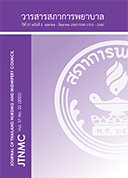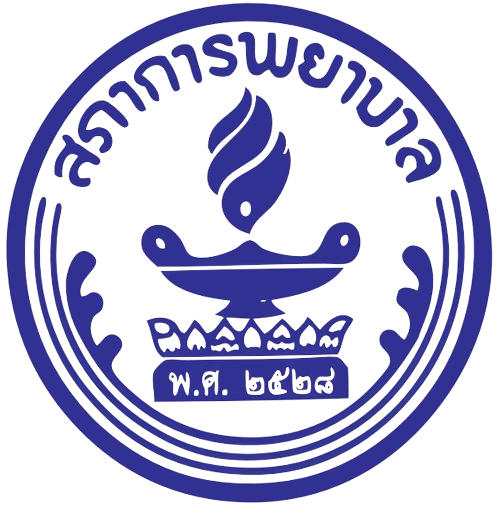Factors Influencing Ischaemic Stroke Patients’ Medication Adherence
Keywords:
ischaemic stroke, medication adherence, perceived susceptibility, perceived severity, perceived barriers, perceived self-effcacyAbstract
Objective: To explore the influence of ischaemic stroke patients’ perceived susceptibility, severity, barriers, and self-effcacy on their medication adherence
Design: Descriptive predictive research
Methodology: The study was conducted on a sample of 149 male and female ischaemic stroke patients aged 18 years or older, who received treatment and follow-ups at a tertiary hospital. Data were collected from March to June, 2021, using a set of questionnaires comprising: 1) a demographic and health information questionnaire; 2) the Hill-bone Medication Adherence questionnaire; 3) a form for perceived susceptibility to recurrent stroke; 4) a form for perceived severity of ischaemic stroke; 5) a form for perceived barriers to medication adherence; and 6) a form for perceived self-effcacy in medication adherence. Descriptive statistics and logistic regression analysis were used to analyse the data.
Results: Most of the sample (61.1%) were males with an average age of 63.23 years (SD=8.9). Their perceived susceptibility, perceived severity, perceived barriers, and perceived self-effcacy were capable of jointly predicting 57.1% of their medication adherence (Nagelkerke R2 = 0.57). The patients’ medication adherence were influenced by their high and moderate levels of perceived susceptibility (OR = 5.05; 95% CI = 1.25, 20.39; p < .05 and OR = 4.96; 95% CI = 1.43, 17.13; p < .05, respectively), high and moderate levels of perceived severity (OR = 8.76; 95% CI = 1.55, 49.42; p < .05 and OR = 3.99; 95% CI = 1.12, 14.10; p < .05, respectively), and high level of perceived barriers (OR = 0.10; 95% CI = .02, .38; p < .05). The patients’ perceived self-effcacy, whether at a high or moderate level, had no signifcant influence on the patients’ medication adherence (OR = .52; 95% CI = .08, 3.39 and OR = .70; 95% CI = .13, 3.78; p > .05, respectively).
Recommendations: Perceived susceptibility, perceived severity, and perceived barriers were identifed as signifcant factors influencing medication adherence in ischaemic stroke patients. Medical professionals are, therefore, recommended to provide patients with information on the susceptibility and severity of the disease in an effort to help them overcome any obstacles to medication adherence.
Downloads
References
Khanevski AN, Bjerkreim AT, Novotny V, Naess H, Thomassen L, Logallo N, et al. Recurrent ischemic stroke: incidence, predictors, and impact on mortality. Acta Neurol Scand. 2019;140(1):3-8.
Lekoubou A, Nkoke C, Dzudie A, Kengne AP. Recurrent stroke and early mortality in an urban medical unit in Cameroon. J Stroke Cerebrovasc Dis. 2017;26(8):1689-94.
Yeo SH, Toh M, Lee SH, Seet RCS, Wong LY, Yau WP. Impact of medication nonadherence on stroke recurrence and mortality in patients after frst-ever ischemic stroke: insights from registry data in Singapore. Pharmacoepidemiol Drug Saf. 2020; 29(5):538-49.
Kim J, Lee HS, Nam CM, Heo JH. Effects of statin intensity and adherence on the long-term prognosis after Acute Ischemic Stroke. Stroke. 2017;48(10): 2723-30.
Algra A, Wermer MJ. Stroke in 2016: Stroke is treatable, but prevention is the key. Nat Rev Neurol. 2017;13(2):78-9.
Ruksakulpiwat S, Liu Z, Yue S, Fan Y. The association among medication beliefs, perception of illness and medication adherence in ischemic stroke patients: a cross-sectional study in China. Patient Prefer Adherence. 2020;14:235-47.
Jiang Y, Yang X, Li Z, Pan Y, Wang Y, Wang Y, et al. Persistence of secondary prevention medication and related factors for acute ischemic stroke and transient ischemic attack in China. Neurol Res.2017;39(6):492-7.
O’Carroll R, Whittaker J, Hamilton B, Johnston M, Sudlow C, Dennis M. Predictors of adherence to secondary preventive medication in stroke patients. Ann Behav Med. 2011;41(3):383-90.
Zhang H, Qian HZ, Meng SQ, Shu M, Gao YZ, Xu Y, et al. Psychological distress, social support and medication adherence in patients with ischemic stroke in the mainland of China. J Huazhong Univ Sci Technolog Med Sci. 2015;35(3):405-10.
Chung PW, Yoon BW, Lee YB, Shin BS, Kim HY, Park JH, et al. Medication adherence of statin users after Acute Ischemic Stroke. Eur Neurol. 2018;80(1-2):106-14.
Kim GG, Chae DH, Park MS, Yoo SH. Factors influencing 1-year medication adherence of Korean ischemic stroke survivors. Int J Behav Med. 2020; 27(2):225-34.
Al AlShaikh S, Quinn T, Dunn W, Walters M, Dawson J. Predictive factors of non-adherence to secondary preventative medication after stroke or transient ischaemic attack: a systematic review and meta-analyses. Eur Stroke J. 2016;1(2):65-75.
Alatawi YM, Kavookjian J, Ekong G, Alrayees MM. The association between health beliefs and medication adherence among patients with type 2 diabetes. Res Social Adm Pharm. 2016;12(6):914-25.
Widjanarko B, Saraswati LD, Ginandjar P. Perceived threat and beneft toward community compliance of flariasis’ mass drug dministration in Pekalongan district, Indonesia. Risk Manag Healthc Policy.2018;11:189-97.
Son YJ, Won MH. Depression and medication adherence among older Korean patients with hypertension: mediating role of self-effcacy. Int J Nurs Pract.2017;23(3).
Sangsongrit N, Pinyopasakul W, Kusuma Na Ayuthya S. et al., Predictors of medication adherence in ischemic stroke patients. ursing Journal.2014;41(2):61-71. (in Thai)
Saengsuwan J, Suangpho P. Self-perceived and actual risk of further stroke in patients with recurrent stroke or recurrent transient ischemic attack in Thailand.J Stroke Cerebrovasc Dis. 2019;28(3):632-9.
Rungsawang S. Factors related to polypharmacy medication adherence among older persons with chronic illness. Journal of Nursing, Siam University.2015;18(35):6-23. (in Thai)
Surasrisakul I and Ua-kit N. Predicting factors of medication adherence among myocardial infarction patients after underwent percutaneous coronary intervention. Journal of The Police Nurses. 2012;4(2):60-70. (in Thai)
Prakobchai S, Kusuma Na Ayuthya S, Wattanakitkrileart D, et al. Factors influencing medication-taking behavior of hypertensive patients. Journal of Nursing Science.2014;32(2):43-51. (in Thai)
Bunsonti N, Soivong P, Tachaudomdach C. Factors related to health behaviors among persons with transient ischemic attack. Nursing Journal. 2020;47(2):262-73. (in Thai)
Khlaihong W, Jitramontree N, Wirojratana V. Factors predicting medication adherence behaviors among older adults with type 2 diabetes. The Journal of Faculty of Nursing Burapha University. 2016;24(1):65-75.(in Thai)
Wangworatrakul W, Suwannaroop N, Moopayak K. Factors predicting to medication adherence among patients with essential hypertension. Journal of The Royal Thai Army Nurses. 2017;18(1):131-9.(in Thai)
Rosenstock IM, Strecher VJ, Becker MH. Social learning theory and the health belief model. Health Educ Q. 1988;15(2):175-83.
Peduzzi P, Concato J, Kemper E, Holford TR, Feinstein AR. A simulation study of the number of events per variable in logistic regression analysis. J Clin Epidemiol.1996;49(12):1373-9.
Train The Brain Forum Thailand. Thai Mental State Examination (TMSE). Siriraj Medical Journal.1993;45(6):359-74. (in Thai)
Poungvarin N, Prayoonwiwat N, Devahastin V,Viriyavejakul A. Dementia in Thai stroke survivors: analysis of 212 patients. J Med Assoc Thai. 1995;78(7):337-43.
Song Y, Han HR, Song HJ, Nam S, Nguyen T, Kim MT. Psychometric evaluation of hill-bone medication adherence subscale. Asian Nurs Res (Korean SocNurs Sci). 2011;5(3):183-8.
Thanukeaw D, Wattanakitkrileart D, Sriyuktasuth A, Chattranukulchai P. Factors predicting medication adherence in patients with essential hypertension [Dissertation]. Bangkok: Mahidol University;2020
Mayet AY. Patient adherence to warfarin therapy and its impact on anticoagulation control. Saudi Pharm J. 2016;24(1):29-34.
Grove SK, Gray JR. Understanding nursing research: building an evidence-based practice. 7th ed. St.Louis, MO: Elsevier Saunders; 2019.
Sung SF, Lai EC, Wu DP, Hsieh CY. Previously undiagnosed risk factors and medication nonadherence are prevalent in young adults with frst-ever stroke. Pharmacoepidemiol Drug Saf. 2017;26(12):1458-64.
Downloads
Published
How to Cite
Issue
Section
License
Copyright (c) 2022 Thai Journal of Nursing Council

This work is licensed under a Creative Commons Attribution-NonCommercial-NoDerivatives 4.0 International License.








